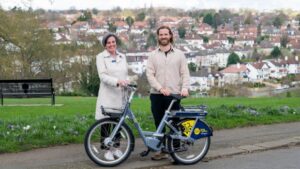Healthy Streets: how London transport policy could save the NHS £1.7bn
The Healthy Streets agenda has the potential to prepare London for an urban future with far fewer cars, where public health is deeply woven into the city’s transport fabric, says Nicholas Sanderson
What would lead to 85,000 fewer people being treated for hip fractures; 19,200 fewer people suffering from dementia; 18,800 fewer people suffering from depression; and an 11% drop in coronary heart disease; in London – every year?
The estimates above would be the cumulative result of every Londoner walking or cycling for 20 minutes a day – saving the NHS £1.7bn over 25 years.
But they also say something else about our city: the cost of our car dependency and the costs of a cityscape is still dominated by motor traffic.
Four in every five square metres of public space in London is street space.
As guardians of the public realm, our transport authorities need to focus on getting our streets fit for our health, unlocking these huge benefits.
Thankfully, a healthy urban transport system is also an efficient one where space is maximised through walking, cycling and public transport. It therefore makes sense to be preparing for an urban future with far fewer cars, even those that remain are likely to be electrically powered and robotically driven.
With this in mind, Healthy Streets for London is the mayor’s first push in this direction. Healthy Streets seems to learn from the North American movement toward Complete Streets but with a much greater public health angle.
While Complete Streets attempt to give dedicated space for all modes of transport to make a street as efficient and equitable as possible, Healthy Streets does so with a clear focus on making streets not just for movement, but better places to be too.
What’s new about Healthy Streets?
But we’ve known this for years. Every public health strategy, every transport strategy and every planning strategy seems to talk up the benefits of walking, cycling and public transport and say that they will prioritise these modes.
But in the real world, progress seems to grind along and the usual priorities of traffic flow seem to undermine attempts to reallocate even a sliver of street space for walking or cycling.
As Jannette Sadik-Khan says, ‘you push the status quo the status quo pushes back’. To which I would typically add, the status quo wins. However, with a new transport strategy on the horizon, pushing the status quo could start to get a little easier.
The mayor’s transport strategy is important as it plots a future course for Transport for London (TfL), the mayor’s main direct agency for change in London. TfL manage the underground, many rail routes, stations, and all buses and major roads.
What’s more they manage all the transport funding for 33 London councils. If London’s councils want to do something it has to be in conformity with the transport strategy to be funded.
 For Healthy Streets to work – and for London to start to look more like Waltham Forest – the whole transport strategy needs to be structured around the ten outcomes of the Healthy Streets approach. The previous focus on smoothing traffic flow and a number of related objectives meant any changes to streets in favour of walking and cycling were stifled or faced an uphill struggle.
For Healthy Streets to work – and for London to start to look more like Waltham Forest – the whole transport strategy needs to be structured around the ten outcomes of the Healthy Streets approach. The previous focus on smoothing traffic flow and a number of related objectives meant any changes to streets in favour of walking and cycling were stifled or faced an uphill struggle.
The previous health action plan by TfL was an excellent document, but largely fell by the wayside of other priorities. This time around, health objectives and targets need to be a top priority, and TfL’s directors held accountable for them.
Currently only a third of Londoners achieve 20 minutes active travel a day while toxic air contributes to 9,500 early deaths every year in London, the combined effort of improving physical activity and air quality in the strategy is a must.
That means targeting an increase in active travel and being very clear that a major contributor to this is building for cycling and improving walking along the way – helping to shift people away from inactive, polluting modes of travel.
Recent analysis of cycling potential concluded that there are 8.17 million trips that could be cycled amounting to 40% of the daily trips made in London. Given that we’re almost at 3% now, this gives an indicator of the enormous potential for cycling in London and a sense of the scale of uplift that is needed.
The major challenge: making it happen
With a transport strategy and organisation set up to deliver Healthy Streets – as the deputy mayor Val Shawcross described – the schemes that will transform London’s streets shouldn’t get such a bumpy ‘computer says no’ ride through TfL.
Yet 95% of London’s streets are controlled by its 33 respective councils. It is incumbent on the mayor to get the boroughs on board with Healthy Streets and work with them to line up the next round of projects for delivery. That means developing clear guidance for boroughs and a set of Healthy Streets standards that make clear the level of improvement required for different contexts.
Nearly ten years ago a coalition of health and transport groups published Take Action on Active Travel, which called for a health check on every transport decision. The principles set out in this document should finally begin to appear thanks to Healthy Streets, but the real challenge ahead for the mayor is delivering against a status quo firmly in favour of motor traffic with three years left in office.
Photo by sludgegulper 













